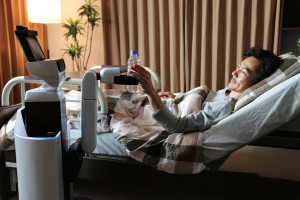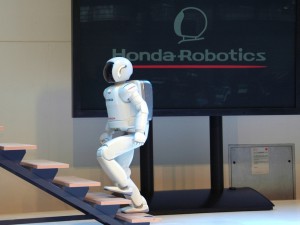
Toyota will begin using its Human Service Robot in trials with healthcare workers to see if they are viable.
And now we all know where the real-life version of the movie iRobot begins … with the introduction of Toyota’s Human Service Robot or HSR.
In the aforementioned film, humans become reliant upon robots to handle life’s mundane responsibilities. The end result is that the robots view humans as a problem begin to implement a plan to rid the planet of them. That’s when Will Smith comes in, sans DJ Jazzy Jeff, and saves the world.
Toyota’s HSR isn’t anywhere near that level of ability or pervasiveness, with its highly maneuverable, compact, and lightweight cylindrical body and folding arm, the HSR can pick objects up off the floor, retrieve objects from shelves, and perform a variety of other tasks.
With the goal of assisting independent home living for the elderly and disabled, Toyota is teaming up with a number of research institutes to found the HSR Developers’ Community. This institute will put forth a cooperative effort to hasten the development and early practical adoption of the HSR.
The HSR isn’t the only entry in the market, as Honda has developed ASIMO, which is short for Advanced Step in Innovative Mobility. The robot can perform a variety of functions, including kicking a soccer ball, which it did to President Barack Obama a few years back.
ASIMO made his debut in 1996 and is now in his third generation. The 4-foot 3-inch, 119 pound robot can walk, run and jump, and, yes, play soccer … sort of. But it was also designed with the idea of providing support to human beings, similar to that of the HSR.
However, it’s not quite ready for that kind of responsibility, according to Honda. However, Toyota’s HSR is heading into the trial stage in working with a variety of health care professionals and other research organizations.
(Audi service techs getting help from ART: Audi Robotic Telepresence. For more, Click Here.)
Initially, starting in September, the HSR Developers’ Community will consist of Toyota and several other institutions already testing the HSR. The community hopes to increase membership by around 10 groups from April 2016 onward, with applications to join the first round of HSR Developers’ Community recruitment being accepted from today. Research projects are expected to last for around two years, with the possibility of extension (pending mutual agreement).
Toyota’s HSRs range in height from 3-foot 3-inches tall to 4-foot 4.5-inches tall. While less human looking than ASIMO, the HSR has more practical applications right now and that could be expanding.
(Click Here for details about Honda’s earnings jumping 20%.)
In fact, they’re offering outsiders a chance to improve upon what they’ve already started. Toyota will hold a “Hackathon” at Toyota’s Mega Web showroom in Tokyo, Japan from Aug. 31 to Sept. 2. Eight teams of five from academic, research, and corporate entities will compete to develop the most innovative application for the HSR. Winners of the event will receive an HSR development kit free-of-charge for one year.
The two makers have been working their robots since more than a decade, automakers around the world have been reliant on robots to help drive down manufacturing costs.
(To see more about Scion’s plans to revive the brand, Click Here.)
They’re used in factories around the world to handle repetitive tasks that humans find difficult or monotonous to perform. However, with ASIMO and HSR, Honda and Toyota may be on the cusp of a new business dynamic for robots: profit center rather than cost saver.

